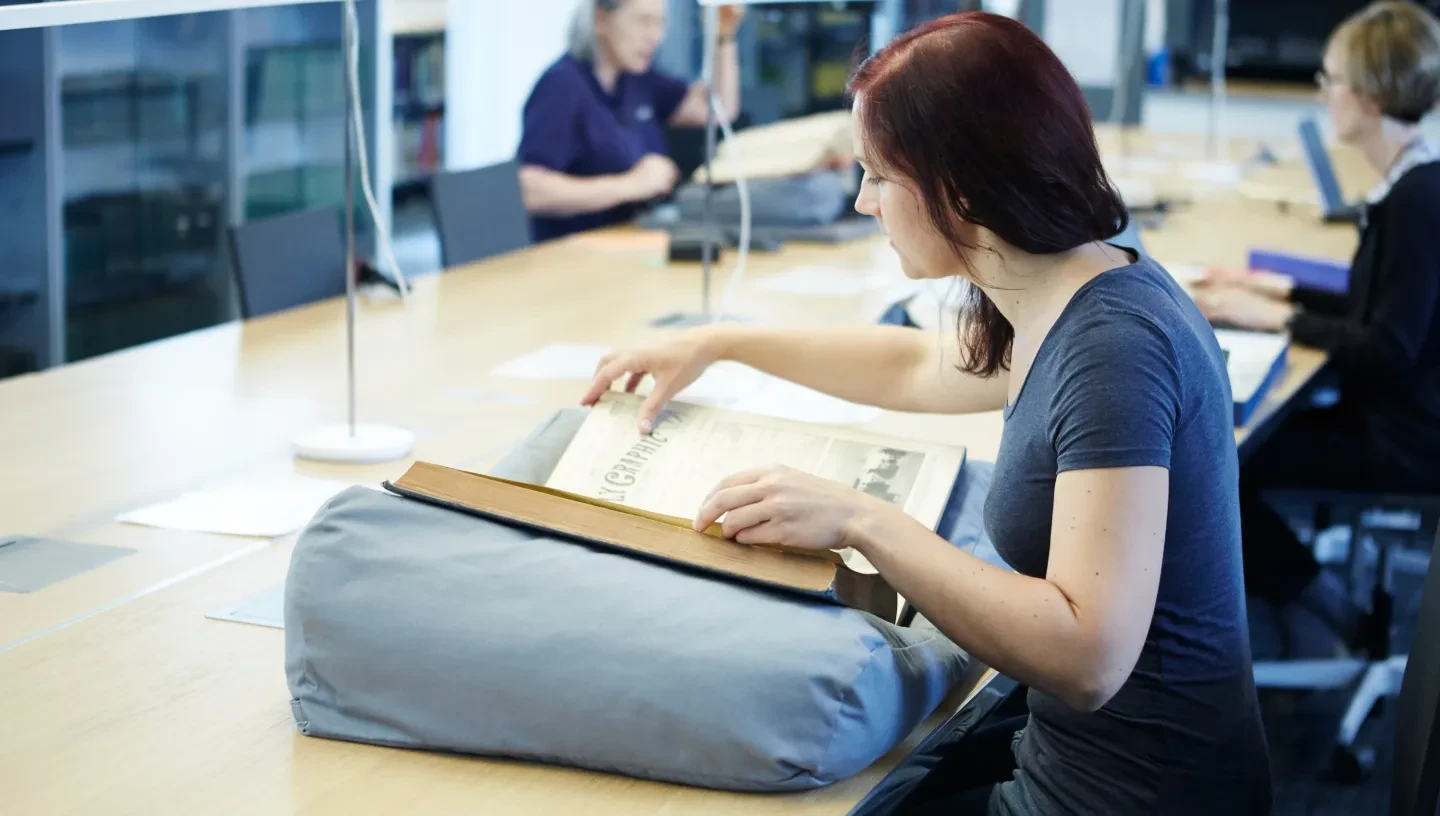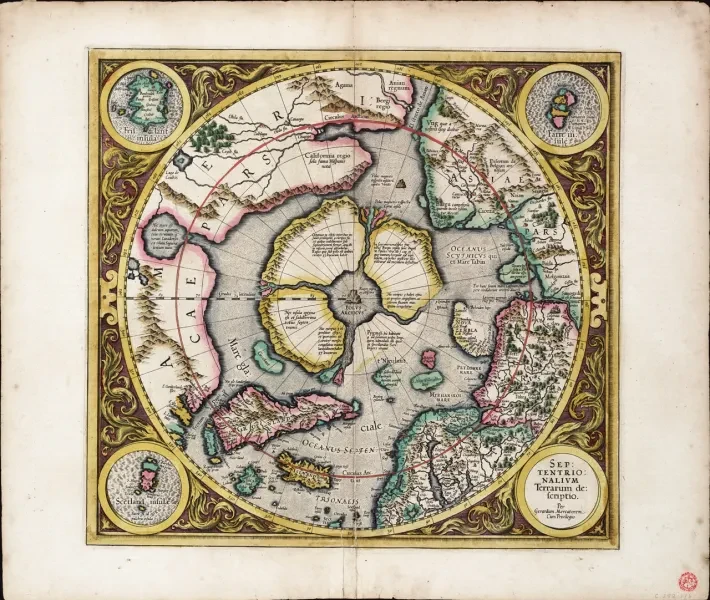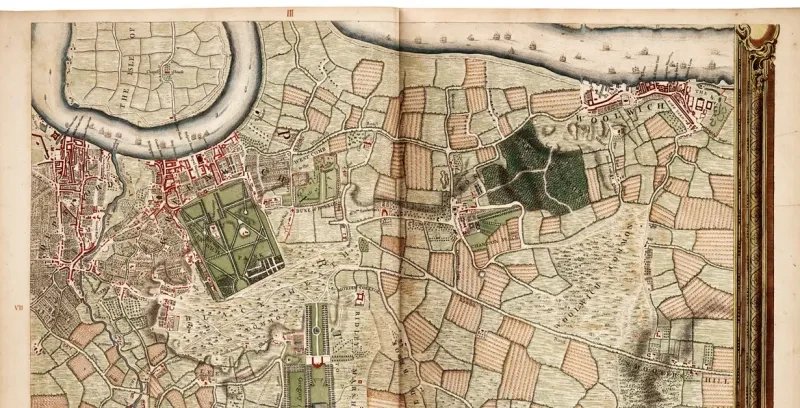
Explore the works and legacy of Richard Hakluyt, an Elizabethan compiler and editor of travel writing at the Caird Library and Archive.
Beginnings
Richard Hakluyt (c.1552-1616) was, despite limited foreign travel, the leading European authority on overseas exploration in the late sixteenth and early seventeenth centuries. An influential exponent for the colonisation of North America, his geographical works fostered a growing sense of English maritime history.
Hakluyt’s interest in geography was stimulated through his cousin (confusingly also called Richard Hakluyt), a lawyer with links to the maritime trade. Inspired by his faith and with his cousin’s encouragement, Hakluyt went to Christ Church, Oxford in 1570 to study divinity and geography. There Hakluyt devoured texts in several languages on voyages and exploration. By the end of the decade, he was ordained as a priest.
Through his cousin he became known to several Elizabethan statesmen and adventurers, including spymaster Sir Francis Walsingham. Hakluyt’s first book Divers Voyages Touching the Discoverie of America (PBB3881/1-2) appeared in 1582. It became an essential resource for those seeking to obtain financial support from investors for colonisation projects, such as Sir Humphrey Gilbert.
Hakluyt’s work also brought him to the attention of diplomat Sir Edward Stafford and his brother-in-law Lord Howard of Effingham, later Lord High Admiral. When Stafford was appointed English Ambassador to France in 1583, Hakluyt joined him as his chaplain. He remained in Paris for the next five years.
While abroad he encountered notable figures including Antonio Aviz, the exiled claimant to the Portuguese throne to which Philip II of Spain had succeeded, and cosmographer Andre Thevet. In a period where tensions between England and European powers were increasing, regular contact with court personalities was useful to Walsingham who had Hakluyt monitor the movements of Spanish and French dignitaries.
Recording the past, inspiring the future
Toward the end of his time in France, Hakluyt produced a new Latin edition of Peter Martyr d'Anghiera’s De orbe novo decades octo (Eight decades from the New World, PBC5901), first published 1511-30. The work consists of eight reports describing early European expeditions to the Americas, including those of Columbus and Cortés. Included is a rare map, dedicated to Hakluyt, in which the name Virginia first appears.
Hakluyt was an admirer of Martyr, believing that Spain was fortunate to have had such a chronicler of their maritime endeavours. In his correspondence, published in 1935 (PBB3918/1-2), he noted a deficiency in English literature and, seeing Martyr as an example to follow, saw a need
to collect in orderly fashion the maritime records of our own countrymen, now lying scattered and neglected, and … bring them to the light of day in a worthy guise, to the end that posterity … may at last be inspired to seize the opportunity offered to them of playing a worthy part.
(E.G.R. Taylor, 2.369)
Hakluyt dedicated his edition of Martyr’s Decades to Sir Walter Raleigh, whose colony at Roanoke – England’s first colonisation effort in North America – had been re-established in 1587. Raleigh had been persuaded by Hakluyt and others to renew his commitment to the venture following its abandonment by Governor Ralph Lane.
Despite the challenges, Hakluyt was keen to support growing interest in North America. Recognising the promotional value of an illustrated edition of Thomas Harriot's influential A Briefe and True Report of the New Found Land of Virginia, he ensured that Theodore de Bry was able to publish it in 1590.
The book describes the land, resources, and people there in some detail. The illustrations were provided by the new Roanoke Governor John White and several copies are held within the Caird Library’s collections. Harriot and White, along with Hakluyt, had convinced Raleigh to restore the ultimately doomed colony.
Principal Navigations
In 1589 Hakluyt’s most celebrated work The Principal Navigations, Voiages, Traffiques and Discoueries of the English Nation first appeared. Hakluyt dedicated it to Walsingham; an important patron who had licensed the work for publication.
A second edition published 1598-1600 expanded the work across three volumes and included naval actions, such as the defeat of the Spanish Armada. It is this iteration that we find in the Caird Library’s collections (PBC3991/1-3).
With Walsingham’s death in 1590 the second edition’s first volume was instead dedicated to Lord Howard of Effingham, the naval commander who had successfully repelled the Spanish Armada. The dedication for the second and third volumes was reserved for Sir Robert Cecil, Secretary of State under Elizabeth I and James VI and I. Cecil had become a major supporter:
I cannot but acknowledge my selfe much indebted for your favourable letters heretofore written in my behalfe in mine honest causes
E.G.R. Taylor, 2.462–3
Like Martyr’s Decades earlier in the century, Principal Navigations is a travel history containing a ‘catalogue of the voyages’ though wider in scope covering some thousand years of history. Hakluyt focused on voyages ‘only of our owne nation’ and excluded those not concerned with the ‘search and discoverie of strange coasts, the chiefe subject of this my labour’ (Taylor, 2.402–3). Entries, Hakluyt reports in the first edition, were drawn from first-hand accounts:
I have referred every voyage to his author: for I am not ignorant of Ptolemies assertion, that Peregrinationis historia [the history of travel], and not those wearie volumes bearing the titles of universall cosmographie … most untruly and unprofitablie ramassed and hurled together, is that which must bring us to the certayne and full discoverie of the world.
With its focus on establishing a narrative of a maritime past for England, it owes much to wider European intellectual ideas and influences. The work enjoyed a wide circulation amongst the elite and several hundred copies survive to the present day. It continues to be an invaluable source for accounts of voyages not preserved elsewhere.
Legacy
Through his reading and writing Hakluyt obtained the status of an international expert on America and, later, Asia – a remarkable achievement for someone who never travelled further than France. He may have planned to travel to Virginia at one point, securing permission to retain his ecclesiastical appointments, but the trip was never made.
Ultimately, his pursuits remained intellectual ones, concerned with the gathering, recording, and disseminating of others’ travel experiences. This was key to building a body of English literature on exploration and fostering a sense of maritime identity. It inspired many prominent Elizabethans – including William Shakespeare – to the possibilities beyond England’s shores.
Today Hakluyt is inexorably linked with the earliest English colonisation efforts of North America. He invested in the Virginia Company, establishing a financial as well as an intellectual stake in English colonial ventures. He also had interests beyond the Americas, serving as an advisor to the East India Company in its early years.
Interest in his life and work has remained strong. In 1809-12 his Principal Navigations was reprinted with additional material Hakluyt had collected on early voyages (PBG1197/1-5). In 1846 the Hakluyt Society was founded. It is dedicated to the history of exploration and regularly publishes scholarly works on navigation, voyages of discovery and historical travel accounts. Over 200 of their titles, along with others on Hakluyt’s work, are accessible in the Caird Library.
Further reading
Anthony Payne, ‘Hakluyt, Richard (1552?-1616), Geographer’, Oxford Dictionary of National Biography
David Harris Sacks, ‘Richard Hakluyt's Navigations in Time: History, Epic, and Empire’, in Modern Language Quarterly 67, 2006, pp.31–62
David A. Boruchoff, ‘Piety, Patriotism and Empire: Lessons for England, Spain and the New World in the Works of Richard Hakluyt’, in Renaissance Quarterly Vol. 62, No.3, 2009, pp.809–58
E.G.R. Taylor, The Original Writings and Correspondence of the Two Richard Hakluyts, London, Hakluyt Society, 1935
Peter Mancall, Hakluyt’s Promise: An Elizabethan's Obsession for an English America, New Haven and London, Yale University Press, 2010








